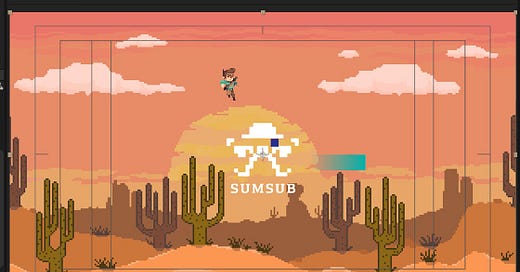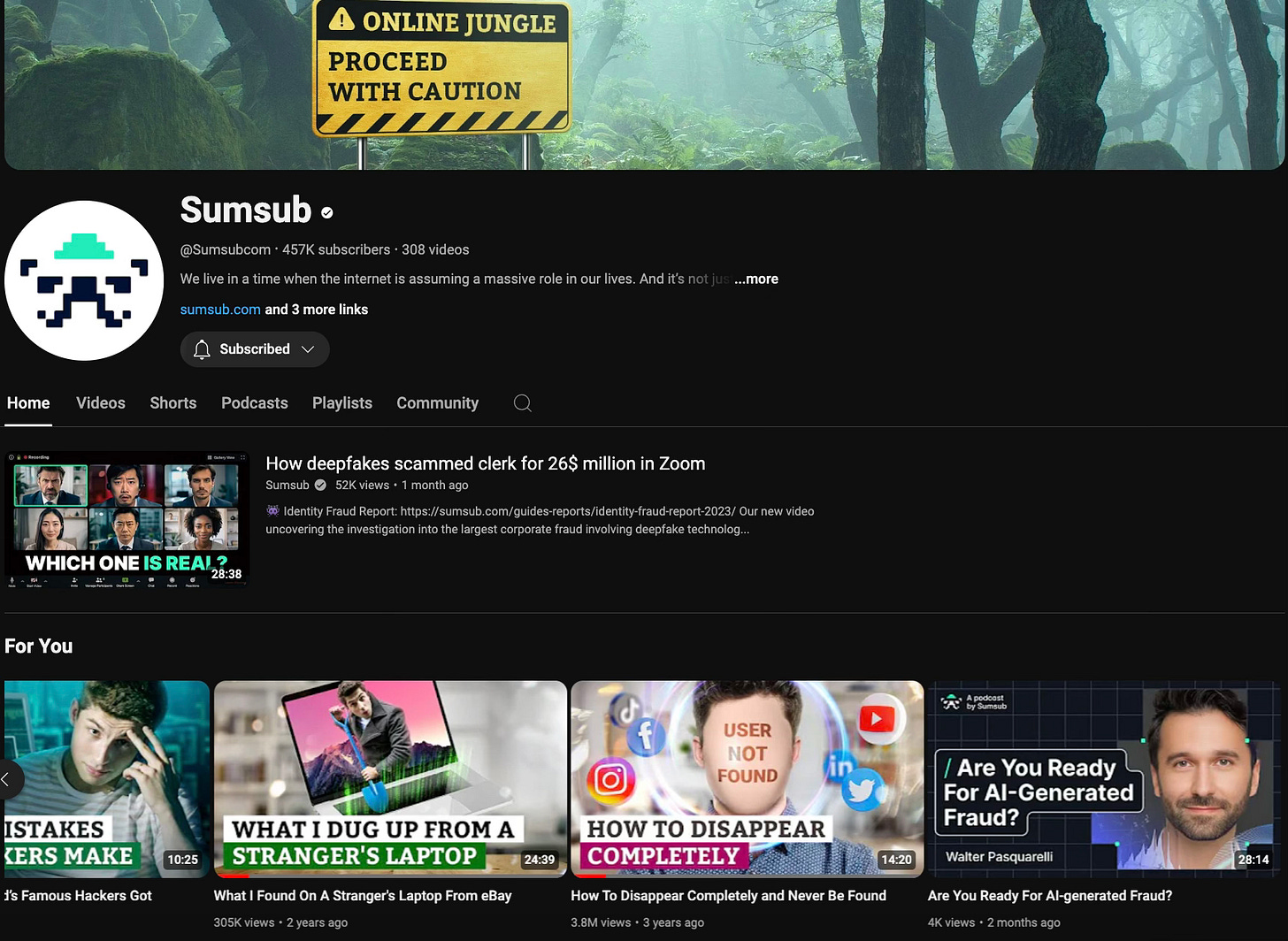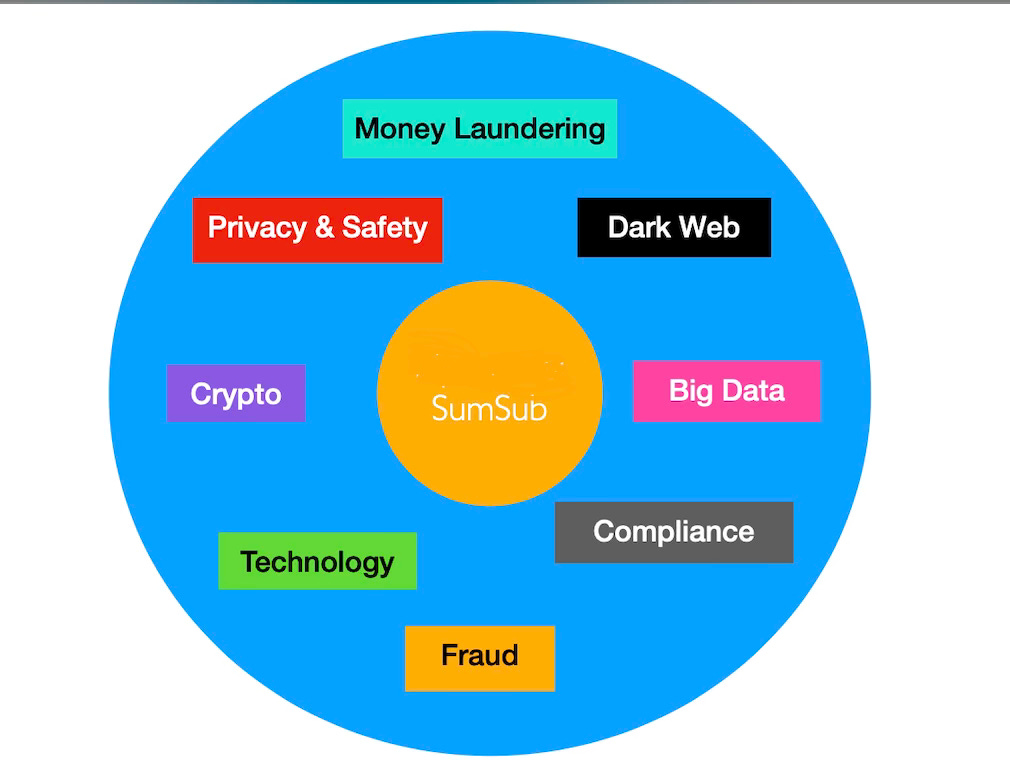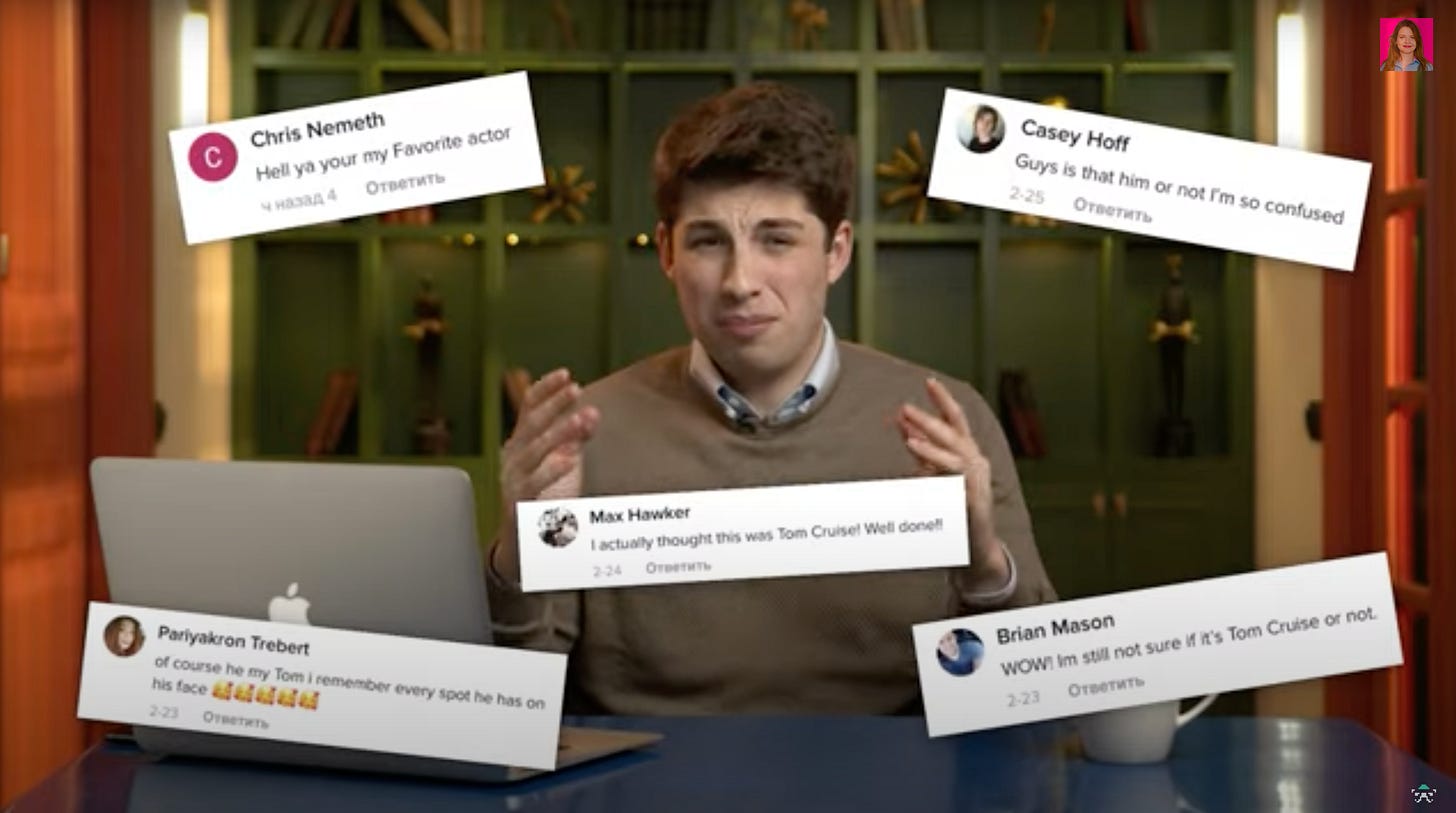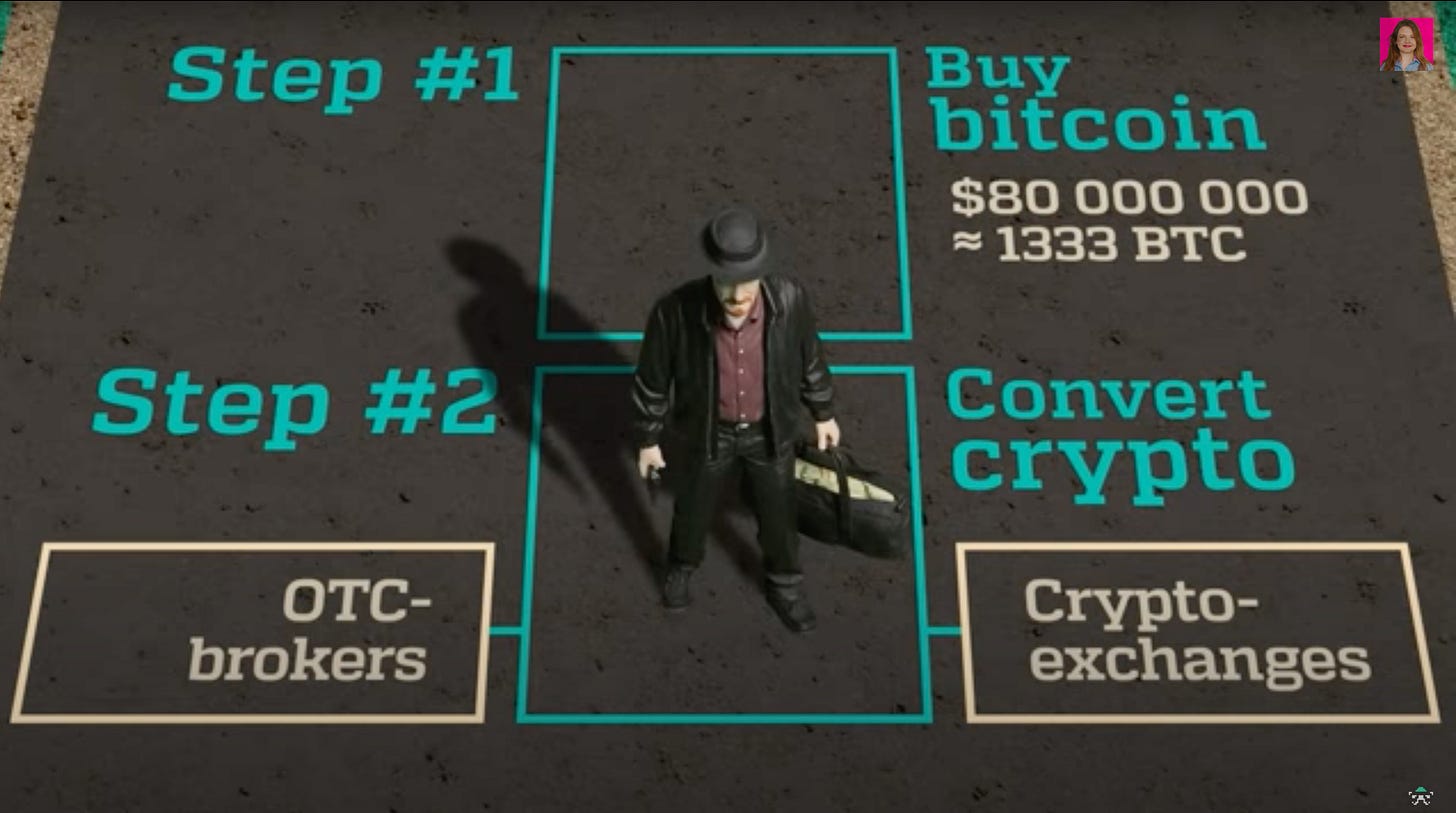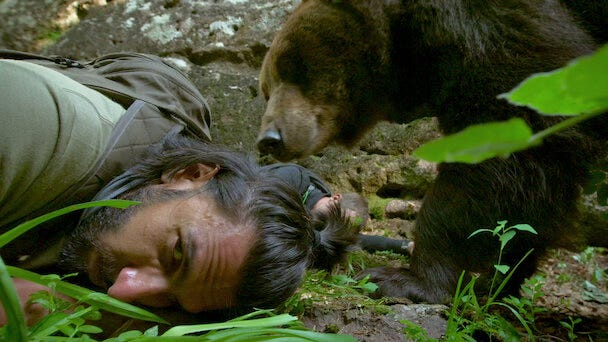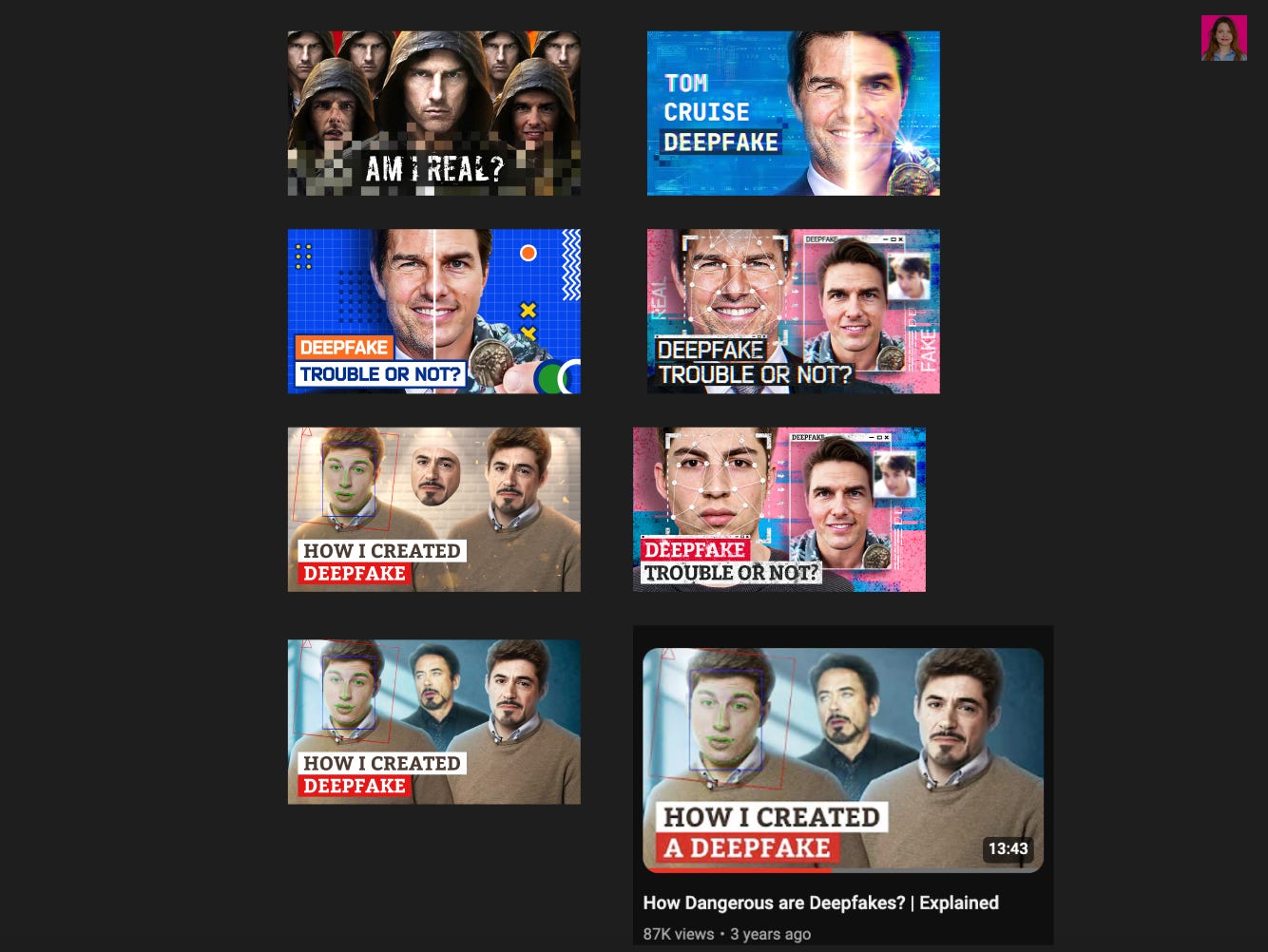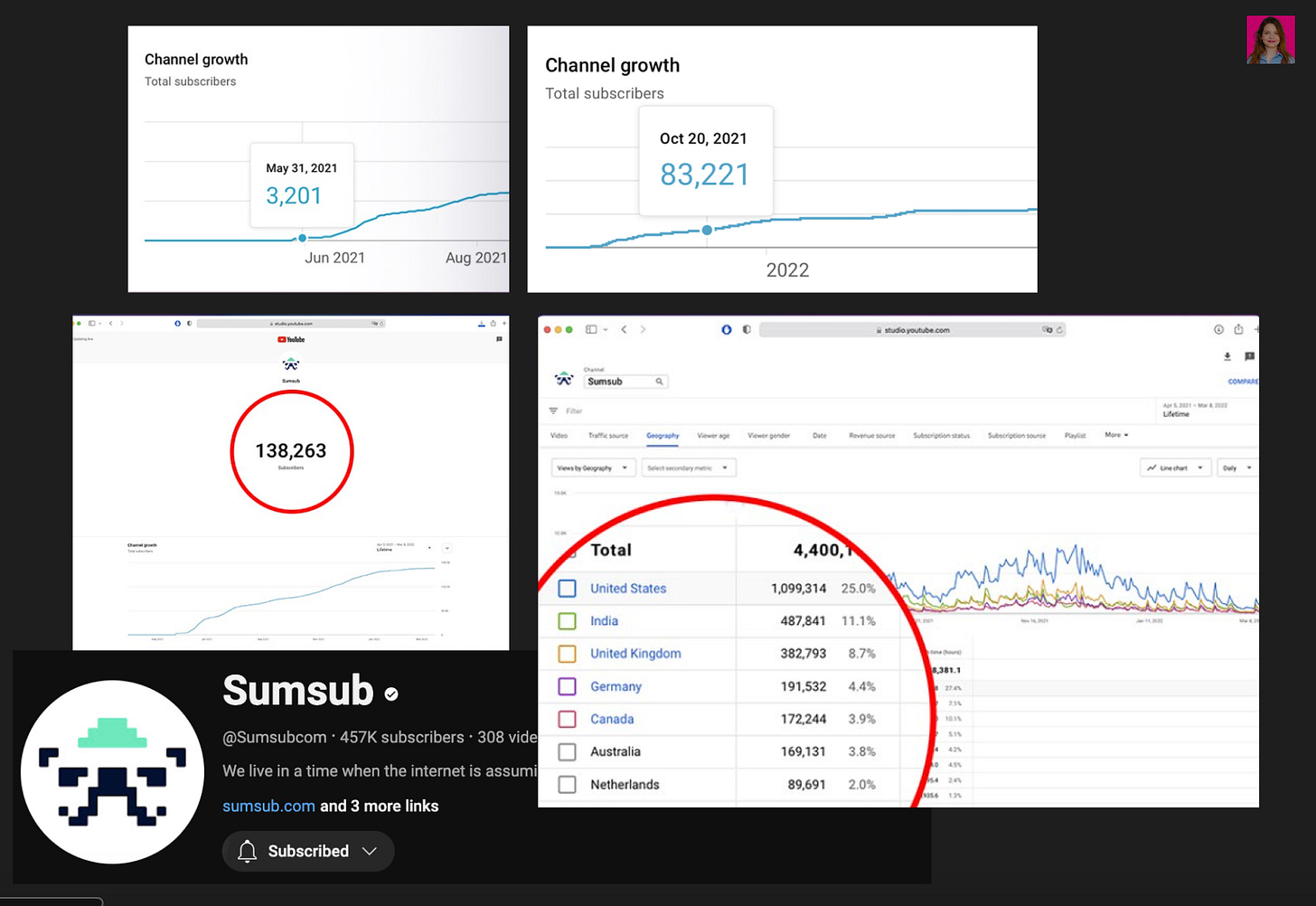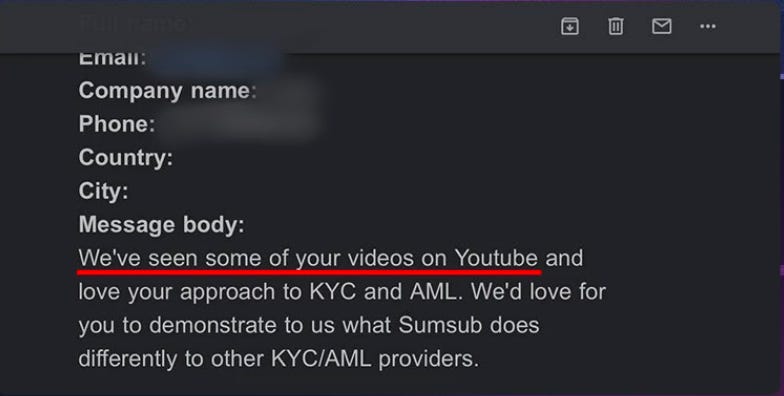How we achieved 30M views and 250k subs on YouTube for a B2B SaaS (just €339 spent on promo)
As of today, Sumsub boasts over 50 million views and nearly half a million subscribers on YouTube. The show more than paid for itself many times over. How have we started with just €339?
50 million views and half a million subscribers. Is that a lot? Absolutely! Sumsub is one of the top 1,000 tech channels on YouTube worldwide. Our views are comparable to some shows on Netflix. Just to put it in perspective, CNBC gets 355 million viewers a month, and BBC gets 318 million.
How the channel hit a crisis and how we doubled our audience while getting out of it is a story for another time. Today’s post is all about the stages of launching the first season year—from development and filming to the behind-the-scenes of this fast and cheap growth.
Business Goals: Why Does a B2B Startup Need YouTube?
Sumsub is an identity verification platform. When the company entered the market (bootstrapped), it was already crowded with well-funded startups.
Here are a few of our competitors:
Onfido: $242M
Jumio: $205.4M
Trulioo: $477M
Veriff: $192.3M
Persona: $217.5M
To capture market share and attract major clients without a sales director or outbound efforts, we in marketing (I'm the former CMO of Sumsub, having grown the company from 0 to €50M ARR) chose a differentiation strategy. We aimed to be more than just a provider—we wanted to become a Lovemark.
Every ad campaign, piece of content, and product launch on social media had to be exemplary—something bright, dramatic, or surprising. It had to cut through the big budgets our competitors were burning and stick in the minds of potential customers—all while being cost-effective.
At some point, we started thinking about YouTube. There were several goals:
The main channels such as field, performance, content, online events, etc. were up and running. The company was focused on enterprise customers, so we started thinking about ABM and looking at strategies.
We wanted to build a community and get closer to our niche audience.
Identity verification and compliance are sensitive issues that require more trust in the provider than almost any other business. This applies to both B2B and B2C. Video content engages all of our senses. It can completely shape a company's relationship with its audience and build trust.
C-level executives and employees from companies within our ICPs also watch videos. Viral content helps drive the top of the funnel, introducing our company and products to a wider audience economically and vividly.
What about you? After a long day at work or during lunch, what would you rather look for on social media? Cringe-worthy moments from The Kardashians or perhaps a lecture on Hegel and his Phenomenology of Spirit?
YouTube is a unique platform that requires a budget and commitment for the first six months after launch. There was a risk of not getting the budget, but we decided to try and convince the founders and the finance team. We put together a presentation with our main hypotheses, the budget for the first six months, and a couple of scenarios for the payback of the channel along with the ROI.
The project got the green light.
But the hardest part came next—how could we reach a complex B2B audience for just €339?
The Show—Strategy and the Audience
YouTube is an investment. And our investments always win. To ensure that, we develop a detailed, formula-based pre-launch strategy.
The Strategy for a Successful Future Show is a comprehensive 100+ page document outlining goals, audience, competition, concept, format, promotion roadmap, path to ROI, and next pipeline. It also includes scenarios for the first two videos.
I'll simplify the strategy for my readers, making the path to millions clearer.
Objectives for the channel at launch time:
Build a core audience as quickly as possible. Without them, we wouldn’t get pushed by YouTube and go viral.
Develop a format that will be organically viewed by millions and will be of interest to the audiences of Sumsub's clients.
The videos on the channel are designed to promote Sumsub's approach, highlight the uniqueness of its knowledge, and contribute to sales by showcasing the company's expertise and that of specific employees.
As an international company focused on EMEA and AMER, it's important to consider the mentality of the top 3 countries when creating content. Otherwise, the videos won't resonate with the audience. And we won't go viral.
Build a team that can consistently deliver high-quality videos on nuanced, complex topics in niche B2B technology.
So to succeed on YouTube we have to understand the mindset of the audience. Without that, people won't watch or subscribe. As a result, we won't get the viral growth we came to the platform for.
This is the same cycle of failure that 90% of brands go through on YouTube.
Growth Tactics
Sumsub operates in the B2B niche. Working in this sector on YouTube will almost certainly lead to project failure. YouTube as a platform is completely B2C oriented, and it's crucial to take this into account when developing a strategy.
So we have a conflict. However, we've come up with a solution, and (spoiler alert!) we'll end up generating a stream of high-quality B2B leads (SQL) with the YouTube show.
How we resolved the conflict:
Competitive analysis revealed: Sumsub's product competitors aren't competitors on YouTube. Most likely, their videos can only reach the target audience through ads or direct links, because they only use YouTube as a video hosting platform to store ads, webinar recordings, conference presentations, and unengaging podcasts. To watch such videos to the end, the mass audience needs to purposefully intend to do so.
SEO. We looked at the semantic core of the business and realized that the market is tight. Competitors don't share information publicly. They're private, especially with product-related information.
The show's strategy: We decided not to target the direct B2B buying audience (there are too few of them for significant growth), but rather people who regularly encounter identity verification through online services such as car sharing or payments.
Remember the uproar when LinkedIn introduced verification?
High Concept
We took a set of topics of interest to a broad audience and mapped them to the interests of Ideal Customer Profiles (ICPs) in various industries and their buying committees.
This brought us to the main theme of the show during the growth phase (high concept)—risk reduction.
In other words:
"Think about it—what if the Internet is an online jungle full of danger?
This YouTube show explains how to stay safe from digital threats.”
And we're not just talking about money laundering or identity theft. We're talking about the whole shebang—everything from online marketplace scams to the deepfake profiles we find on LinkedIn today.
We assumed that among the hundreds of thousands of YouTube subscribers would be our ICPs as well. To hedge the risks of this assumption, we did some research on our target audience before we launched. It turns out that our ICPs are out there on the platform. They are searching for information on the same topics and watching similar videos.
Meanwhile, for the mass audience, we will be seen as practical experts in digital and legal analysis, as well as security—the good guys. And for the Sumsub brand, that's critical. And true!
Audience building
We've researched detailed profiles of our potential YouTube viewers—where they're from, what they like, and how they relax.
And hey, I'm planning to dive deeper into the whole audience-building strategy in a separate post. This is a big thing, a critical step towards getting our channel over the million view mark.
Show Format
Next, we nail down the format of the show. We want our viewers to get exactly what they loved and what they subscribed to. Also, having this document at hand makes it a breeze for the team to produce high-quality videos on schedule.
Stage 1: The Visuals
The Foundation of the Format
Given Sumsub's need for sales managers and attorneys to be media savvy, especially when they're out there at conferences or negotiating with clients, the core of our format is pretty straightforward: It's all about getting people in front of the camera.
Rhythm
Since we don't have our visual product per se, we decided to use video editing and motion graphics to get the engagement rate we wanted.
Intro
For the channel, we decided to use two types of intros:
— Option 1:
A short and clear introduction that clearly states the value to the viewer. Why should they watch? What will it give them? The hook is the value.
— Option 2:
In the second intro, the hook should be a mood-setting, intriguing thing.
Video editing
Bringing complex topics to life is no walk in the park.
The tricky part? Well, when it comes to risk management, there are no action-packed scenes or gripping footage. It's mostly contracts, insights into algorithms, and employee expertise.
But fear not, folks! We can spice things up by carefully crafting visual storytelling for every sentence said.
Here are some techniques we've included (below please find examples with names of technics in captions):
We avoid stock footage. They often feel cheesy and too promotional. Our idea of the right footage is all about storytelling. We show real-life scenarios—opening interfaces, Googling, visiting websites, doing calculations in Google Sheets, and more—all in real-time.
It won't be needed often. We'll use it when we need to simplify a complex phenomenon, schema, or process.
...and so on.
For Sumsub, we've outlined a few dozen editing techniques in the "Show Bible"
Stage 2: Meaning
Topic sources
For our project, we created a cloud of topics covering technology, privacy, compliance, and several other topic blocks. Each block consisted of about 20-30 broad topics.
For each video, we wanted to mine these blocks, working with Sumsub experts to select ideas through a rigorous filtering process.
Once we’ve got our hands on a topic, it's time to fine-tune it and shape it into something fascinating.
Alright, we've done the groundwork. Ready to dive into the next stage?
Formats
Format—is the structure of a media product, consisting of parameters and elements that define the type and style of that content. In other words, do we want a video or a podcast? A reality show or a scripted video? Long-form or short-form? What genre are we leaning towards? And so on...
Choosing a format is a key part of any strategy, as formats can vary greatly.
For Sumsub, we've come up with three formats, one for each stage of the YouTube funnel:
Top of Funnel—Edutainment
These are videos for the general public that touch on topics such as pop culture, politics, or futurism. Include elements related to the Sumsub as a small part of the story.
Middle of the Funnel—Experiments and Investigations
Aimed at a broad audience, but potentially interested in risk management, at least from a "how do these systems work with my identity" perspective. Such videos require detailed, exclusive information on topics that Sumsub is an expert in.
Bottom of the Funnel - Educational Format
This format is aimed at the narrowest audience and focuses entirely on Sumsub's processes. Prior to the show's launch, we decided not to publish this format during the initial phase, but rather when we'd reached KPIs for audience growth.
This format isn't about traffic; it's about converting viewers into quality leads and engaging with the expert community. In the end, we moved this format to a separate channel and began to cultivate the expert audience separately.
I'll talk more about that in a separate post. On the channel we're discussing today, this format is represented by podcasts with external experts as part of Sumsub's ABM strategy.
Stage 3: Packaging
One of the final concepts for the show was a "wildlife" theme. Survive the Internet the Bear Grylls way.
Imagine a tech executive trying to survive in the unforgiving online jungle. Instead of lions, there are fraudulent online casinos. Instead of piranhas—Tinder romance scammers.
As a preview—a photo of an executive with a thumb drive in his mouth (instead of a knife) jumping over a mountain with a rope. And at the top there is a slogan - "SURVIVE IN THE WILDLIFE OF THE INTERNET".
Would you click?
After all the iterations, we stayed close to the concept of the Internet jungle, but tweaked it a bit and went with Sherlock Holmes instead of Bear Grylls.
That's how we translated that into the packaging:
The name and the profile pic of the show
Since we wanted to promote the brand, the name had to include the name Sumsub in the title.
At the growth stage, we didn't want to look too promotional, as that would be a barrier to subscription. That's why we made a logo in the jungle concept—a stop danger sign:
Thumbnails or Previews
A preview has to have its own intrigue in order to be noticed.
It's even regrettable that we went off concept with Bear Grylls! Before we got to the final thumbnail, we went through 16-20 iterations. Take a look at how the approach changed.
Title sequence
Opening sequences are important to set the tone and make a creator's videos recognizable. We decided to make one for Sumsub in a jungle style, but a little more positive.
Here are a few opening sequences that we alternated between. For example:
They were also used to promote the company's brand in other marketing campaigns—from emails to webinars and offline events.
Channel banner
Banner's important, but primarily for image and aesthetics, as most people don't actually see it, they access videos from feed or search.
But we're perfectionists, so we designed the banner to support the concept of danger and jungle. It's the kind of image that would justify a stop sign in front of it.
What do you think?
Locations
Since our narrator was constantly traveling, we couldn't afford to choose a fixed location. Filming could take place in London, Berlin, Cyprus or Paris, depending on his travels. We needed to find locations quickly and within budget, as well as quality videographers.
Once we had the date, script and storyboard from the videographer, we could book a studio or a scenic Airbnb to further enhance the atmosphere for each video.
Casting
The host is the most important element of any video. Often, entire YouTube or TV shows are created specifically for one person.
The host had to be someone who, first and foremost, had the time to take part in the filming and to work on the scripts. In addition, this person had to come from the company, understand the product and processes, and have the necessary expertise. While a "talking head" could be filmed, it would result in a completely different growth rate and higher risks for the client.
After all, the host is the face of the show-a real person with his or her own opinions, emotions, and background.
Casting is worth writing about separately. In short, viewers unconsciously read a lot into the person they see in a video:
— Are they experts or not?
— Charismatic? Interesting or just boring?
— Is there something about them that commands respect? Is their opinion worth listening to?
— The "face" of the channel needs to be motivated to participate in the show. Playing an expert isn't the way to do it. They need to be themselves. They need to be natural and speak in their own words, not be scripted.
We cast internally, vetted several candidates, and settled on our first host. It was Bradley, a charismatic business development manager from London. Remember I mentioned the Sherlock Holmes vibe?
Filming the pilot
We quickly assembled a team for this project and began shooting within the first month of production.
Scriptwriters and marketers wrote the scripts, the host refined them, and designers and strategists finalized the packaging. We also had an on-set crew to handle the filming.
Eventually, we produced four high-quality, diverse pilot episodes. Now it was time to move on to promotion.
Audience Growth
Overall, audience growth on YouTube is a large topic that many still misunderstand.
For Sumsub, we decided to try integrating with an influencer and then see how it goes. We created a comprehensive database and reached out to potential partners. The average cost in this market is around $10-20k per integration.
But you've probably heard it before: good content sells itself.
One influencer turned down the money we offered him and shared a link to our video for free. It turned out that he was genuinely curious about how fintech services verify their users, so he decided to share a quality video that explained this to his audience.
Another influencer wanted $339 for an integration. His blog was pretty small, very engaged. This was enough to give one of our videos a "push" and get it into YouTube's recommendations. A month after the launch, the video had over a million views, which brought us 30,000+ subscribers.
And that was it! From there, each of our videos started getting hundreds of thousands of views by itself. All we had to do was engage with the community (another critical part I'll discuss in a separate post) and continue to produce quality content.
Numbers and business results
We reached 200,000 of subscribers in less than a year. We even made it into the top 1,000 tech channels on YouTube worldwide.
All without any additional investment. No YouTube shorts, no ads on other platforms, no buying views. We just relied on quality content.
Leads for our products started coming in within the first month. In conversations with prospects—whether from outbound efforts or at conferences—sales managers reported that many mentioned that they first heard about us from YouTube. Team members wearing hoodies with the Sumsub logo were recognized by YouTube viewers in unexpected places, such as hiking along a Norwegian fjord.
Later on, we integrated our YouTube channel into our account based marketing (ABM) strategy.
I can't disclose all the details, but I can say that the channel has paid for itself many times. And we have the numbers to prove it.
Even through the toughest times of recession, market panic, and dangerous revenue drops, the founders never cut the YouTube budget. The financial benefits were clear and precisely calculated.
The channel has weathered two major crises, and each time we came out on top. But I'll get to that later.
What about YouTube organic growth interests you?
* I'm always keeping a close eye on the feedback, and will be planning content based on what's requested - both here and in DMs.
If you'd like to meet or suggest a topic privately, drop me a line on LinkedIn.

